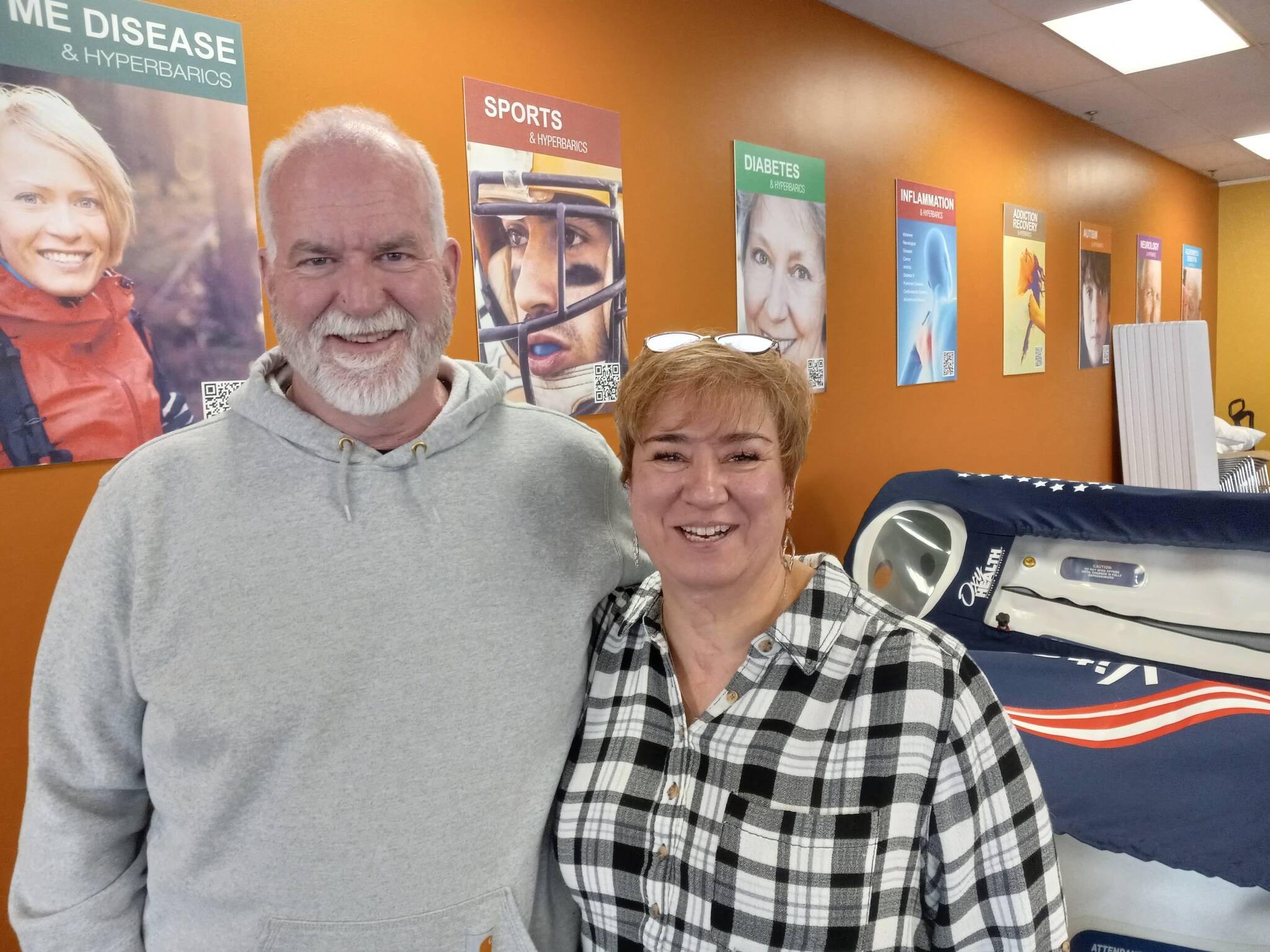After Dr. Tamoro McDonald and her husband, Shane, slipped the oxygen tubes into my nose, zipped up the soft, inflatable chamber and turned some dials, I found myself as cozy and snug as I would have been had I settled into a pup tent with pillows.
But the hyperbaric chambers at Hyperbarics NW, which the McDonalds opened earlier this year at 4435 A St SE. Suite G, four doors south of their Docere Integrated Medicine, are about so much more than being comfy.
They use highly-concentrated oxygen to help heal the human body.
“They are serious medical devices, and we are seeing benefits in everything,” said Dr. Tam.
That claim may surprise people familiar only with the use of hyperbaric chambers to relieve the bends, which is a serious, painful and potentially life-threatening condition associated with nitrogen bubbles that accumulate in the lungs of deep-sea divers as they return to the surface.
But the positive effects of breathing in for an hour the highly concentrated oxygen the devices provide on concussions, strokes, after-strokes, long-term COVID-19, diabetic ulcers, Parkinsons’ disease, burns, wounds, autism and many other medical issues are generating serious buzz.
“We use hyperbarics as medicine, as we do at Docere,” said Dr. Tam. “They’ve gotten to be popular. It was really important that we ended up getting more. You’d be amazed at the things we see them benefiting.”
As with the man who came to her for help after he’d suffered five strokes in one month. At that time, 60 days after the man’s neurologist had let him go, he was blind in his right eye, paralyzed on the right side of his face, paralyzed in his right arm, and partially paralyzed in his right leg, with impaired cognitive functions and slow, sluggish speech.
“We put him in hyperbaric every day,” said Dr. Tam. “I came in on my days off. We made sure that he got it every single day. And after 40 dives, every single symptom had dissipated. His sight came back, no more paralysis anywhere, 100 percent function.
“He’d been told when he went to an ophthalmologist after losing his sight that there was no possibility of getting it back. So not only had he gotten it back by the time he went to see them again, his sight was better than it had been before his stroke,” said Dr. Tam.
The devices themselves do not heal, Shane stresses. They help the body to heal.
But how do they do that?
According to Dr. Tam, the chambers use oxygen under pressure, and all of them at the Auburn site concentrate the gas down to 1.3 atmospheres, the exact same concentration people breathe in the pressurized cabins of airplanes flying at 30,000 to 40,000 ft.
Although oxygen is “the most reparative thing that can be put in the body,” she said, human beings are limited to the 21 percent they get in the air they breathe. But in the hyperbaric chamber, all of the nitrogen, fluorine and neon that’s normally in the air is concentrated out so the person inside breathes 100 percent oxygen.
That does not mean, however, that the chamber is filled with and pressurized by 100 percent oxygen, which would be quite dangerous.
“It’s being pressurized by the compressor, but you’re breathing 100 percent oxygen,” said Dr. Tam. “So now, if you think about it, we’ve already improved your health. You’re breathing 100 percent oxygen instead of 21 percent. We follow the gas law that states that if you put enough pressure on a molecule of gas, you can shrink it and dissolve it into a fluid. When you put 1.3 atmospheres on an oxygen molecule, and you’re in the chamber, it shrinks that molecule enough to dissolve it into your plasma. Our plasma isn’t limited. It can go anywhere from head to toe. So basically you get in for an hour, and you’re filled up with oxygen.”
Try to think of a 2-liter bottle of pop, Dr. Tam suggests.
“You look at it on the shelf and you don’t see a bunch of bubbles because it’s pressurized. Take the top off, the bubbles all get big and come back out. It’s the same thing when you get out of hyperbaric: they get big you don’t lose them. Instead they 100 percent repair you from head to toe for 24 to 36 hours., which is pretty incredible,” said Dr. Tam.
As it was in the case of the man cited above.
“Impressive. Forty dives at one 1.3 atmospheres and fully recovered from the damage,” said Dr. Tam.
Given benefits like that, it’s no wonder that hyperbaric chambers are growing ever more popular. But the flip side of that popularity has resulted in a sort of wild west of unlicensed, untrained operators.
As of last year, Hyperbarics Northwest became the only training center on the West Coast for people who want to be trained and certified in the use hyperbarics. Indeed, during the weekend prior to this interview, the site was transformed into a four-day training certification, drawing people from all over the world. People can also receive training in Florida and New Jersey.
Certification is through the International Board of Undersea Medicine, which is the same organization that governs diving laws.
“We want people to know it is a medical device. I think once the regulations are finished, we probably won’t be around helping everybody on the West Coast get trained,” said Dr. Tam.
For people reluctant to undergo the treatment, including anxiety sufferers and autistic youngsters, the McDonalds have a special way to entice them in: their little dog, Roxie. Seems the friendly little canine has become a tail-wagging companion and comforter to more than a few people inside the chambers.
Any strange effect on the dog?
“She’ll probably live longer,” Shane said with a laugh.


